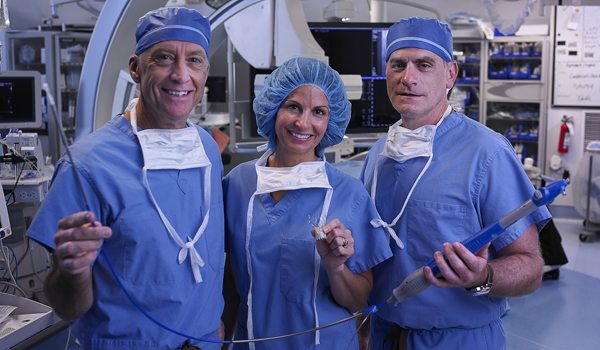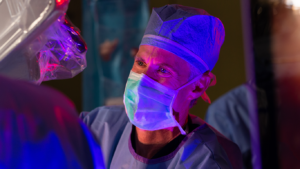The health of Arizona remains a concern.
Arizona residents’ health is below average. The state ranks as the 29th healthiest in the nation, according to United Health Foundation’s 2016 America’s Health Rankings Annual Report. The good news is that the No. 29 ranking was an improvement over the previous year, when Arizona ranked 30th. But the state remains in the bottom half.
Healthcare remains a concern for the state’s business leaders, as well.
“It makes sense that healthcare costs have moved up on the list of challenges as the country grapples with healthcare policy at the national level,” says said Don Garner, CEO of Alliance Bank of Arizona.
According to Alliance Bank of Arizona’s 2017 Arizona Leaders in Business Survey, healthcare is one of the top three business challenges in Arizona for 2017.
While there are concerns swirling around the healthcare sector, Arizona is also breaking ground with healthcare innovations in medical research, treatment and diagnosis. Less than four months into 2017, a study by Phoenix-based Banner Alzheimer’s Institute was featured in a Newsweek cover story; Scottsdale-based GlobalMed signed a deal to sell its technology in China, Hong Kong, Macau and Taiwan; ASU’s Biodesign Institute is developing a test for pancreatic cancer; Tucson-based Accelerate Diagnostics got FDA approval for its kit that tests blood for bacterial infection; TGen identified a rare genetic mutation that causes developmental delays in children; and the University of Arizona opened its $136 million Biomedical Sciences Partnership Building on the Downtown Phoenix Biomedical Campus, which will house labs for cancer, molecular medicine and other health research.
And while healthcare costs remain a concern for the state’s business leaders, companies like Redirect Health and Akos MD are developing innovative programs and methods for businesses and individuals to reduce their healthcare costs.
But they are not the only innovators that are game-changers in the healthcare sector. From pediatrics to geriatrics, Arizona experts are re-imagining and redefining healthcare as we know it.
Alzheimer’s disease
Can you imagine a vaccine that could prevent a person at risk for Alzheimer’s disease from ever developing symptoms?
That could happen and the world would have Arizona researchers to thank.
Currently, researchers working to develop an Alzheimer’s vaccine are recruiting healthy individuals who are at risk of the onset of clinical symptoms of Alzheimer’s. Participants have to carry two ApoE4 genes, a genetic risk factor for Alzheimer’s. The effort is being spearheaded by the Alzheimer’s Prevention Initiative, which is led by Banner Alzheimer’s Institute.
Under the leadership of Banner Alzheimer’s Institute Executive Director Eric Reiman, researchers and institutional leaders in the state have established the Arizona Alzheimer’s Consortium and generated more than $1 billion in grants, contracts and other investments, and made major contributions to the study of Alzheimer’s disease, related disorders and the aging brain.
Cancer research
Banner MD Anderson Cancer Center is involved in multiple research studies involving immunotherapy, a cutting-edge treatment that unleashes the body’s immune system to fight tumors.
“The clinical trials use different methods which aim to reprogram the patient’s own blood immune cells, essentially teaching them to seek and destroy cancer cells,” says Javier Munoz, MD, MS, FACP, a hematologist and director of the immunotherapy program at Banner MD Anderson Cancer Center in Gilbert.
Dr. Munoz has several immunotherapy clinical trials available for patients battling lymphoma. These trials offer the potential to help patients with non-chemotherapy approaches by harnessing their own immune system. In theory, immune cells could eventually be trained to fight several types of cancers and this is a key technique to re-educate our immune system to attack cancer.
Cancer treatment
There are multiple approaches being evaluated to improve outcomes for treating patients with cancer, according to Glen Weiss, director of clinical research and medical oncologist for Cancer Treatment Centers of America at Western Regional Medical Center.
“Immunotherapy is one of the major breakthroughs for treating advanced cancer,” Weiss says. “Currently, it is effective in shrinking tumors for a durable period of time for a select percentage of patients. A major area of focus is implementing combinations of therapy to improve on those results.” Similarly, Weiss says targeted therapy works for a select percentage of patients and often for a limited duration of time. Efforts are now focusing on how to better identify those patients that may have exceptional outcomes with these treatments.
“Beyond testing tumors to identify potential new ways to treat cancer, there is also an increasing research focus on using circulating DNA from the tumor collected from blood samples as a new source of monitoring response to treatment and identify new possible treatments,” Weiss said. “This is less invasive, but still a fairly early technology.”
Cardiology
St. Luke’s Medical Center, the first hospital in Arizona to offer a same-day coronary angioplasty through the radial artery in the wrist, is reporting significantly improved outcomes and cost savings for patients and the health system using the new artery access point. As a result, the less-invasive procedure is attracting national attention.
“St. Luke’s Medical Center has one of the most unique catheterization labs in the state, which has allowed us to get ahead of the curve in offering a better patient experience with better patient outcomes,” said Dr. Richard Heuser, chief of cardiology at St. Luke’s Medical Center. “As a result, both patients and the health care system are enjoying significant cost savings. Since we began offering the procedure in 2010, the hospital has seen upwards of $750,000 in annual healthcare savings.”
St. Luke’s Medical Center is still one of few hospitals in the U.S. performing same-day cardiac catheterization using the radial artery as a standard practice. The endovascular procedure, which improves blood flow to the heart, is typically performed using the femoral artery in the groin as the more common point of access to diagnose and treat arterial diseases, including coronary artery disease and peripheral artery disease. The new artery access point has shown a marked difference in the recovery time, pain level, reduction in complications and overall better short- and long-term outcomes for patients. Dr. Heuser says the radial approach reduces complications by 80 percent compared with the femoral approach.
Dermatology
Platlet rich plasma — or PRP — is a new and exciting trend in dermatology and aesthetic medicine, says Dr. Lee Laris of Phoenix Skin. It is being used to help regrow hair in hereditary and other types of hair loss.
“PRP delivered via injection or thru microneedling is also showing promise in skin rejuvenation, improving skin elasticity and increasing collagen,” Laris says. “Scars and other defects, as well as areas of volume loss have responded to PRP mixed with fat, which results overall improved results.”
Topical application of PRP has been used to speed the healing of open ulcers and stretch marks have been improved with local injection of PRP or topical application after lasering.
“Overall PRP is becoming a promising treatment addition in the field of dermatology,” Laris says.
Dentistry
The dental industry is constantly striving to introduce new innovations to patients, experts say.
“One of the leading forefronts of dental innovations is the various types of dental implants currently on the market that successfully fuse to bone,” says Dr. Whitney Wright, founding orthodontist at Risas Dental and Braces. “They are extremely stable and a highly esthetic and conservative way to replace missing teeth.”
Wright says there are a few groups of bio-engineers who are currently developing a way to use stems cells to regrow teeth that have been lost.
“This technology is cutting edge, and will take years before we will see any real application in the dental field,” Wright says.
One innovation that has been developed and quickly put into use is a change in the way dental impressions are taken, according to Peggi Rohner, a registered dental hygienist with Douglas Family Dentistry.
“Perhaps you have a bad gag reflex or boney projections in the floor of your mouth that make this process incredibly uncomfortable,” Rohner says. “Now we have the ability to use a very high-tech, high-resolution hand-held scanner to capture images of the teeth. The scans generate a 3D model that is electronically transferred to the lab. The results are a more comfortable visit for you and final restorations that fit better due to eliminating impression material distortion.”
Dental insurance
Although dental care costs have remained fairly stable over the years, per capita medical care costs have continued to rise.
“Employers and consumers have limited dollars to spend on overall health care, so dental carriers like Delta Dental of Arizona are challenged to find innovative ways to manage costs,” says Brad Clothier, executive vice president of business development for Delta Dental of Arizona. “One of the easiest ways to do so is by introducing plan options that focus on wellness, such as third cleanings for people with certain medical conditions or by allowing members to receive preventive care without it being deducted from their annual benefit maximum. We also provide dental action reports for our mid-to-large size clients that help employers guide their workforce toward positive oral health outcomes.”
Healthcare education
General healthcare innovations in healthcare education — including advancements in technology and multidisciplinary and simulation-based training — benefit healthcare education by providing applied learning, the continuing education of instructors, as well as positively affecting the quality of healthcare.
“While it may seem obvious to focus on the cost-effective telemedicine or virtual cadaver innovations, effectively training the allied health care professional who is assisting the doctor or comforting a patient during a procedure requires a modern, creative and efficient approach to innovation,” says Jen Spurlin, Pima Medical Institute’s corporate director of education.
Spurlin says Pima Medical Institute uses a variety of proprietary innovations in training allied healthcare students to be knowledgeable and technically proficient, while recognizing the value in developing emotionally intelligent students who can successfully communicate and connect with patients.
Heart care
In what could be a game-changer in heart care, Abrazo Arizona Heart Hospital is performing a Transcatheter Aortic Valve Replacement (TAVR) procedure on low-risk patients as part of a national clinical trial.
TAVR is a minimally invasive alternative to open-heart surgery that enables a surgeon to implant a replacement valve through a small incision near the femoral artery in the groin, eliminating the need to crack open a patient’s chest.
Currently, the procedure is available to patients with severe aortic stenosis – a narrowing of the aortic valve that obstructs blood flow to the heart and the rest of the body.
“Unlike many other areas of medicine, cardiology continues to progress at a breakneck pace,” says Dr. Timothy Byrne, physician executive director of cardiac services for Abrazo Community Health Network. “We are at the forefront of new testing, treatments and technologies that will help patients not only live longer, but also remarkably better.”
Medical research
The Translational Genomics Research Institute (TGen) in Phoenix is a leader in the world of medicine that innovates through the development of tools and technologies that embrace the staggering complexity in biological systems. This comprehensive, integrated approach to wellness focuses on prevention of disease, early detection of disease risk and individualized treatment plans for each patient.
“Without question, Arizona bioscience innovation is accelerating,” says Dr. Jeffrey Trent, president and research director of TGen. “Innovation is what TGen is all about, using the human genome to find new ways to diagnose and produce new treatments for the diseases that plague humanity.”
Examples include TGen’s Center for Noninvasive Diagnostics, which uses genetic fragments in circulating blood to provide early-warning and disease-tracking systems for cancer and neurologic disease.
“Through our new alliance with California’s City of Hope, TGen is combining genomic information with research, using of the body’s own immune system to treat and defeat cancer,” Trent says.
Mobile apps
New mobile apps now enable people to meet with a primary care physician and specialist to obtain medical care, with the goal of providing convenience and more affordable care, according to Dave Allazetta, CEO for UnitedHealthcare of Arizona. The cost of a video-based virtual visit is usually less than $50 and may provide significant savings when compared to costs for similar minor medical needs treated at a doctor’s office (approximately $80), urgent care facility (approximately $160) or emergency room (approximately $650), according to UnitedHealthcare claims data. Recent advances in audio and video technology are enabling people to obtain a diagnosis and necessary prescriptions for minor medical needs including allergies, sinus and bladder infections, bronchitis and other conditions.
The Internet has transformed how people purchase goods and services and it is doing the same for healthcare, Allazetta says. Some new online and mobile services enable people to comparison shop for healthcare based on quality and cost. The Health4Me app, available on iPhone and Android devices, enables users to identify nearby healthcare providers and facilities, as well as compare quality and estimated cost information for more than 850 common medical services. With a growing number of Americans now enrolled in consumer-directed health plans, more people are using online and mobile healthcare transparency resources. More people (32 percent) are using websites and mobile apps to comparison shop for healthcare, up from 14 percent in 2012, according to the recent UnitedHealthcare Consumer Sentiment Survey.
Pediatrics
Many patients at Phoenix Children’s Hospital are being treated for serious conditions such as cancer, asthma and infections that require multiple medications. But combining multiple medications can negatively impact kidney function and even create kidney injuries. To compound the issue, Electronic Health Records (EHRs) include multiple disparate pieces of data about each patient’s condition and medications, making it nearly impossible for a physician to think through all of the possible side effects and interactions of the drugs.
To address the issue, Phoenix Children’s created a big data solution that provides physicians and pharmacists with very early warnings about drug side effects and potential kidney damage.
The kidney function monitoring system monitors every child in the hospital. It pulls together data from myriad data streams to analyze creatinine tests, which measure the functions of the kidney, along with information such as diagnoses and medications to gauge kidney function trends for every patient at the hospital. Now physicians and pharmacists can quickly identify any changes in kidney functions and address those changes before any damage occurs.
Pediatric cardiology
Phoenix Children’s Hospital is the first healthcare facility in the world to offer a non-invasive, drug-induced computed tomography (CT) stress test for young adults with heart anomalies who cannot complete traditional, exercise-based EKGs. The test sheds new light on patients’ risk of coronary artery stenosis and helps providers determine whether invasive surgery is required to correct coronary insufficiencies.
This procedure offers several critical advantages over other imaging modalities, like stress echocardiography and myocardial profusion imaging (MPI). While the stress echo allows physicians to obtain images in patients with complex heart disease, there are no standards for using the data and no understanding of the impacts of testing over time. Likewise, there’s scant information about MPI. It’s such a novel procedure that only one study has been published on MPI.
Just as important, the dose of ionizing radiation in Phoenix Children’s procedure is drastically lower than other modalities. The amount of radiation exposure from MPI is 20 times higher than PCH’s drug-induced CT stress test, which is of utmost concern for children with congenital heart anomalies and other complex conditions who will require imaging throughout their lives.
Radiology
Phoenix Children’s Hospital is among the first children’s hospitals to marry 3-D printing and advanced post-processing technologies. PCH’s division of pediatric radiology found a way to determine the exact size of a tumor using 3-D measurement, a drastic improvement over standard protocols.
As treatment is often based on tumor size, precise measurement arms oncologists with the information they need to determine the most appropriate therapy and can mean the difference between life and death for children fighting cancer. 3-D measurement also allows doctors to identify subtle changes in tumor size or shape over time. This is critically important for determining whether chemotherapy or other treatments are shrinking the mass.
Retina care
Just in the past decade, game-changing innovations in the treatment of retinal diseases have occurred and Retinal Consultants of Arizona has played a role in bringing every approved pharmacologic treatment for retinal disease to market, especially in the two leading causes of treatable vision loss and blindness: Macular Degeneration and Diabetic Eye Disease.
In patients with Wet Macular Degeneration, Avastin, Lucentis, and Eylea, is used intravitreally to neutralize vascular endothelial growth factory. This monthly treatment helps maintain or improve vision in 90 percent of patients, according to Derek Kunimoto, MD, JD, managing partner at Retinal Consultants of Arizona & Retinal Research Institute.
With diabetes on the rise and millions at risk, we see many patients with Diabetic Macular Edema. Illuvien is an implantable steroid that releases medication into the eye for three years. Once injected, the steroid acts to decrease vascular permeability and improve vision.
Technology
Medical Technology or “medtech” innovation is helping to provide people in Arizona and around the world with a better quality of life and, in some cases, saving lives.
“Medtech covers a broad spectrum of technologies including diagnostic innovations from companies like HTG Molecular Diagnostics in Tucson and VisionGate in Phoenix, that are focused on providing healthcare providers and their patients the information they need in the fight against cancer,” says Joan Koerber-Walker, president and CEO of the Arizona BioIndustry Association. “Medical devices like those created at Medtronic in Tempe help patients with chronic diseases — including diabetes and heart disease — to better manage their diseases and live longer and more fulfilling lives. Just a few miles away, the innovators at Bard Peripheral Vascular design and deliver devices that range from devices that help clear your arteries of dangerous plaque to making life better for cancer patients with well-designed ports for the delivery of their life saving medicines.”
Those are just a few examples of the more than 400 medtech companies that call Arizona home.




